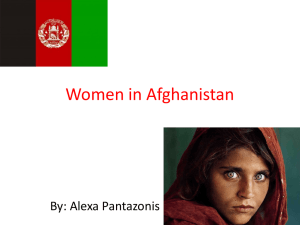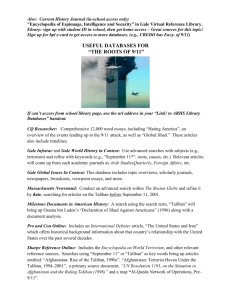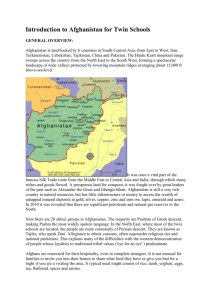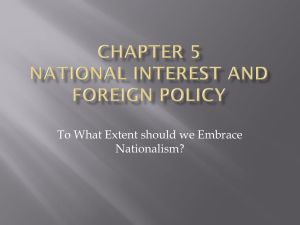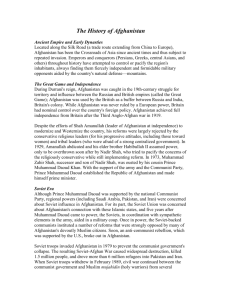Kite Runner Historical Background
advertisement
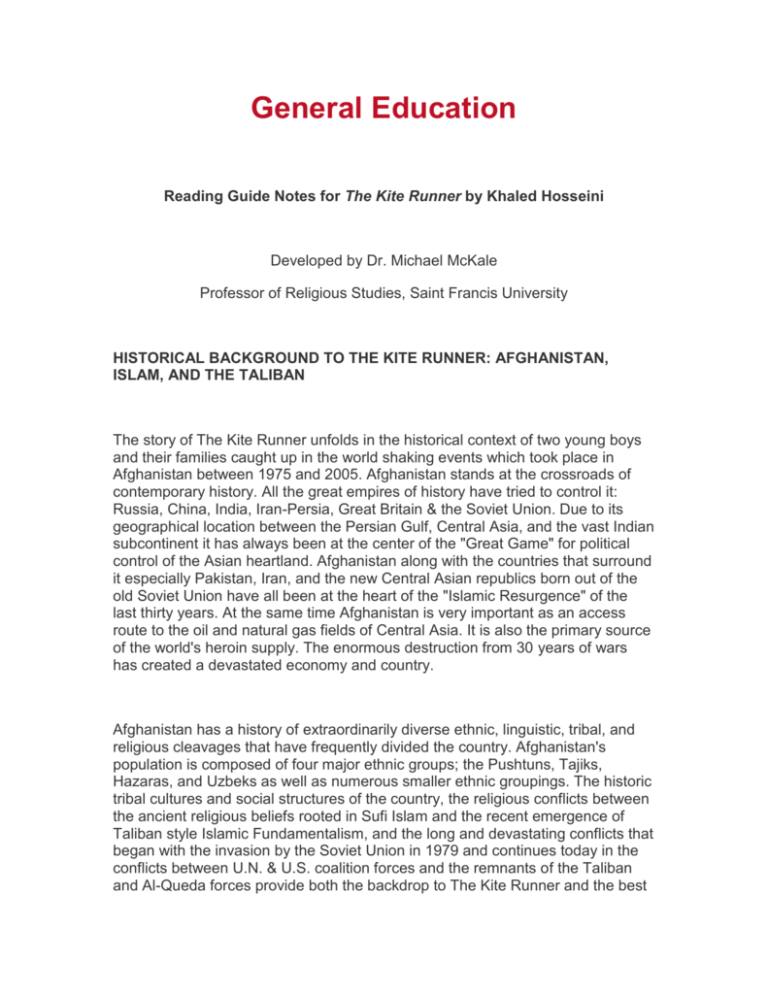
General Education Reading Guide Notes for The Kite Runner by Khaled Hosseini Developed by Dr. Michael McKale Professor of Religious Studies, Saint Francis University HISTORICAL BACKGROUND TO THE KITE RUNNER: AFGHANISTAN, ISLAM, AND THE TALIBAN The story of The Kite Runner unfolds in the historical context of two young boys and their families caught up in the world shaking events which took place in Afghanistan between 1975 and 2005. Afghanistan stands at the crossroads of contemporary history. All the great empires of history have tried to control it: Russia, China, India, Iran-Persia, Great Britain & the Soviet Union. Due to its geographical location between the Persian Gulf, Central Asia, and the vast Indian subcontinent it has always been at the center of the "Great Game" for political control of the Asian heartland. Afghanistan along with the countries that surround it especially Pakistan, Iran, and the new Central Asian republics born out of the old Soviet Union have all been at the heart of the "Islamic Resurgence" of the last thirty years. At the same time Afghanistan is very important as an access route to the oil and natural gas fields of Central Asia. It is also the primary source of the world's heroin supply. The enormous destruction from 30 years of wars has created a devastated economy and country. Afghanistan has a history of extraordinarily diverse ethnic, linguistic, tribal, and religious cleavages that have frequently divided the country. Afghanistan's population is composed of four major ethnic groups; the Pushtuns, Tajiks, Hazaras, and Uzbeks as well as numerous smaller ethnic groupings. The historic tribal cultures and social structures of the country, the religious conflicts between the ancient religious beliefs rooted in Sufi Islam and the recent emergence of Taliban style Islamic Fundamentalism, and the long and devastating conflicts that began with the invasion by the Soviet Union in 1979 and continues today in the conflicts between U.N. & U.S. coalition forces and the remnants of the Taliban and Al-Queda forces provide both the backdrop to The Kite Runner and the best context for understanding Afghanistan and its people. The wars of the last thirty years including the invasion of the Soviet Union and the Mujahedeen Resistance which lasted from 1979-1989, the Civil War between the 7 mujahedeen groups and regional warlords from 1989-1994, the war between the Northern Alliance and the Taliban which took place between 19942001, and finally the conflict between the U.S.-Northern Alliance and the TalibanAl-Queda forces from 2001 to the current time have absolutely devastated Afghanistan. There are over 2.2 million refugees in Pakistan, 2.4 million in Iran, another 1 million living in camps inside Afghanistan, and over a million Afghan refugees in exile around the world. Most Afghans of any means have fled to other parts of the world much like the family of Baba and Amir in The Kite Runner. Islam has unified the people of Afghanistan since the 8th century and was a key factor in the creation of the nation and in the resistance movements to the Russian, British, Soviet and other invaders in history. The form of Islam practiced in Afghanistan was rooted in Sufi Islam. Afghanistan was a "developed" country by the late 1960's with education, a modest standard of living, and a civil peace. The Sunni and Shia form of Islam practiced in Afghanistan was tolerant of other Muslim sects, other religions, and modern lifestyles. Afghan mullahs never believed Islam could be forced on people. Sectarian conflicts over the "True Islam" or pushing one interpretation of Islam was never promoted. Many diverse forms of Islam were welcomed in Afghanistan. In fact, 80 percent of Muslims in Afghanistan belong to the Sunni Hanafi sect, the most liberal of the four Sunni schools of Islamic thought and law. The Sufi movement in Islam, which speaks to the heart of Islam, promoted education, religious and cultural tolerance, and respect for the diversity of peoples. All of this changed with the Soviet invasion, the arrival of the Afghan-Arabs led by Osama bin Laden in the 1980's, and the rise of the Taliban in the 1990's. The Taliban implemented an extreme interpretation of the Sharia or Islamic law that appalled most Afghans and the Muslim world. Before the Taliban, Islamic extremism never flourished in Afghanistan and there was little precedent in Afghanistan's Islam for a Taliban like movement. Rural Pashtun tribal culture was very conservative but also hospitable and generous of spirit. In some rural areas, Pashtunwali, a conservative social code, is still part of the culture. Most Taliban punishments were drawn largely from the traditional Pashtunwali tribal code & not the Islamic Sharia. The story of The Kite Runner unfolds in this historical context. HISTORICAL TIMELINE 1747 an Ahmad Shah Abdali, a Pushtun commander, declares his territory independent country 1784 The modern state of Afghanistan established 1839-42 First Anglo-Afghan War results in British control but a British army of 16,500 men is annihilated outside Kabul, one of the greatest defeats of British arms in history 1878-80 1893 2nd Anglo-Afghan War: The British invade Afghanistan The Durand Line, dividing ethnic Pushtuns is established by the the British as the Afghan-Indian boundary. 1907 British & Russians establish boundaries of modern Afghanistan 1918 The 3rd Anglo-Afghan war leads to Afghanistan's Independence 1933-63 Constitutional Monarchy established under Zahir Shah 1947 Britain withdraws from Indian subcontinent, Pakistan established as an Islamic Republic, Britain ignores Pushtun demands for an independent Pushtunistan 1963-73 Democratic Experiment under Zahir Shah ends on July 17, 73 Key Historical Events during The Kite Runner 1973-1979 First Republic of Afghanistan established by Daoud Shah, cousin of Zahir 1978-1992 1979 1980-1991 Afghanistan Communist Party rules country Invasion of Afghanistan by the Soviet Union in December U.S. supplies millions of dollars to the Afghan resistance to the Soviets 1987-1989 Withdrawal of the Soviet Union from Afghanistan 1987-1992 Internal Civil War between various mujahadeen groups 1992-1996 The Islamic State of Afghanistan is established by the Northern Alliance. 1994 1996-2000 Taliban emerges and begins take-over of Afghanistan Establishment of the Taliban led Islamic Emirate of Afghanistan 1998 Eight Iranian diplomats are murdered and over 5,000. 5,000 Hazaras in Mazar-i-Sharif are massacred by the Taliban Sept. 9, 2001 The "Lion of Panjsher," Ahmad Shah Massoud, the leader of the Northern Alliance, the main opposition to the Taliban, is murdered by two assassins posing as journalists and acting on the orders of Osama bin Laden October - The Northern Alliance with aid from an international coalition November power led by the U.S. military removes Taliban & Al Queda from October 2004 Hamid Karzai elected President of Afghanistan ADDITIONAL READING Girardet, Edward. "Eyewitness Afghanistan." National Geographic. December 2001. Goodson, Larry P. Afghanistan's Endless War: State Failure, Regional Politics, and the Rise of the Taliban. Seattle: University of Washington Press, 2001. Griffin, Michael. Reaping the Whirlwind: The Taliban Movement in Afghanistan. London: Pluto Press, 2001. Hosseini, Khaled. Dreaming in Titanic City. New York: Riverhead Books, 2006. "Humanity Denied: Systematic Violations of Women's Rights." In Afghanistan Human Rights Watch, Volume 13, No. 5, October 2001. Jacquard, Roland. In the Name of Osama Bin Laden: Global Terrorism and the Bin Laden Brotherhood. Chapter Four: "Among the Taliban." Durham: Duke University Press, 2002. Marsden, Peter. The Taliban: War, Religion and the New Order in Afghanistan. London: Zed Books, LTD, 2001. Nojumi, Neamatollah. The Rise of the Taliban in Afghanistan: Mass Mobilization, Civil War, and the Future of the Region. New York: Palgrave, 2002. Pazira, Nelofer. A Bed of Red Flowers: In Search of My Afghanistan. New York: Free Press, 2005. Rashid, Ahmed. Taliban: Militant Islam, Oil, and Fundamentalism in Central Asia. New Haven: Yale University Press, 2001.

